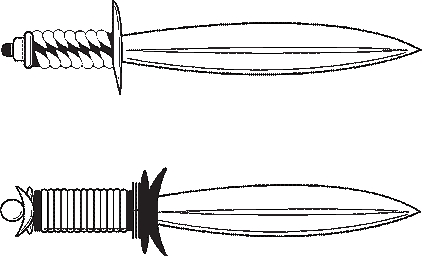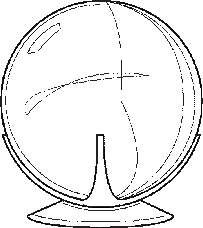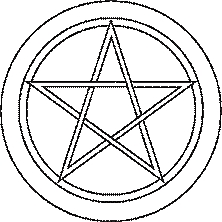Wicca (6 page)

White-Handled Knife
The white-handled knife (sometimes called a
bolline
) is simply a practical, working knife as opposed to the purely ritualistic magic knife. It is used to cut wands or sacred herbs, inscribe symbols onto candles or on wood, clay, or wax, and in cutting cords for use in magic. It is usually white-handled to distinguish it from the magic knife.

Some Wiccan traditions dictate that the white-handled knife be used only within the magic circle. This would, of course, limit its usefulness. It seems to me that using it solely for ritual purposes (such as harvesting flowers from the garden to place on the altar during ritual) confirms the tool’s sacredness and so allows its use out of “sacred space.”
Crystal Sphere
Quartz crystals are extremely popular today, but the quartz crystal sphere is an ancient magical tool. It is exquisitely expensive, selling for twenty dollars to thousands of dollars, depending on size.Most crystal balls on the market today are glass, leaded glass, or even plastic. Genuine quartz crystal spheres can be determined by their high prices and inclusions or irregularities.
The crystal has long been used in contemplative divination. The diviner gazes into the ball until the psychic faculties blossom, and images, seen in the mind or projected by it into the depths of the crystal, reveal the necessary information.

In Wiccan ritual, the crystal is sometimes placed on the altar to represent the Goddess. Its shape (spheroid) is Goddess-symbolic, as are all circles and rounds, and its icy cold temperature (another way to determine genuine rock crystal) is symbolic of the depths of the sea, the Goddess’ domain.
Then, too, the crystal may be used to receive messages from the Gods, or to store energy raised in ritual. Some Wiccans scry in the crystal to call up images of the Goddess or of past lives. It is a magical object touched with the divine, and if you find one, guard it carefully.
Periodic exposure to moonlight, or rubbing the crystal with fresh mugwort, will increase its ability to spark our psychic powers. It may be the center of full moon rituals.
Cup
The cup is simply a cauldron on a stem. It symbolizes the Goddess and fertility, and is related to the element of water. Though it can be used to hold water (which is often present on the altar), it may also contain the ritual beverage imbibed during the rite.
The cup can be made of nearly any substance: silver, brass, gold, earthenware, soapstone, alabaster, crystal, and other materials.
Pentacle
The pentacle is usually a flat piece of brass, gold, silver, wood, wax, or clay, inscribed with certain symbols. The most common, and indeed the only necessary one, is the pentagram, the five-pointed star that has been used in magic for millennia.
The pentacle was “borrowed” from ceremonial magic. In this ancient art it was often an instrument of protection, or a tool used to evoke spirits. In Wicca, the pentacle represents the element of earth and is a convenient tool upon which to place amulets, charms, or other objects to be ritually consecrated. It is sometimes used to summon the Gods and Goddesses.
Pentacles are also hung over doors and windows to act as protective devices, or are ritually manipulated to draw money owing to the pentacle’s earth associations.

The Book of Shadows
The Book of Shadows is a Wiccan workbook containing invocations, ritual patterns, spells, runes, rules governing magic, and so on. Some Books of Shadows are passed from one Wiccan to another, usually upon initiation, but the vast majority of Books of Shadows today are composed by each individual Wiccan.
Don’t believe the stories in most other Wiccan books that one single Book of Shadows has been handed down from antiquity, for each sect of Wicca seems to claim that their own is the original, and they’re all different.
Although until recently a Book of Shadows was usually handwritten, today typed or even photocopied versions are quite common. Some Wiccans are even computerizing their books—to create, as friends of mine call it, the “Floppy Disc of Shadows.”
To make your own Book of Shadows, begin with any blank book— these are available in most art stores and bookshops. If you cannot find a bound blank book, any lined exercise book will do. Simply write in this book any rituals, spells, invocations, and magical information that you have either composed or found elsewhere and would like to preserve.
Remember—all Books of Shadows (including the one in section III) are suggestions as to ritual, not “holy writ.”Never feel tied down to these words. In fact, many Witches use three-ring binders, shuffling around pages, adding or subtracting information from their Book of Shadows at will.
It is a good idea to copy your spells and rites by hand.Not only does this ensure that you’ve read the work completely, it also allows easier reading by candlelight. Ideally, all rites are memorized (there’s nothing more distracting than having to read or glance at the book), or created spontaneously, but if you would read your rites, be sure your copies are legible by flickering firelight.
Bell
The bell is a ritual instrument of incredible antiquity. Ringing a bell unleashes vibrations that have powerful effects according to its volume, tone, and material of construction.
The bell is a feminine symbol and so is often used to invoke the Goddess in ritual. It is also rung to ward off evil spells and spirits, to halt storms, or to evoke good energies. Placed in cupboards or hung on the door, it guards the home. Bells are sometimes rung in ritual to mark various sections and to signal a spell’s beginning or end.
Any type of bell can be used.
These are some of the tools used in Wiccan ritual. Working with them, familiarizing yourself with their powers, and pouring your own energy into them, you may find their use becoming second nature. Gathering them is a problem, but this can be seen as a magical test of the seriousness of your Wiccan interest.
As you collect each tool, you can prepare it for ritual. If old, it should be stripped of all associations and energies; you don’t know who owned the tool, nor to what purposes it may have been used.
To begin this process, clean the tool physically using the appropriate method. When the object is clean and dry, bury it (in the earth or a bowlful of sand or salt) for a few days, allowing the energies to disperse. An alternate method consists of plunging the tool into the sea, river, or lake, or even your own bathtub after purifying the water by adding a few pinches of salt.
Don’t ruin a good piece of wood by wetting it; similarly, don’t mar the finish of some other object by allowing it to contact salt. Use the most appropriate method for each tool.
After a few days, dig up the tool, wipe it clean, and it is ready for magic. If you use the water method, leave the object submerged for a few hours, then dry it. If desired, repeat until the tool is clean, refreshed, new.
There are consecration ceremonies for the Wiccan tools in section III, as well as preparation rites in the Herbal Grimoire section there. Both are optional; use as your intuition dictates.
*
Some Wiccans claim that brooms were “ridden” while hopping along the ground, much as are hobby-horses, to promote fertility of the fields. Then, too, it is believed that tales of Witches riding brooms through the air were unsophisticated explanations of astral projection.
*
More broom lore can be found in chapter 13 of
The Magical Household
(Llewellyn, 1987).
WICCA
UNDERSTANDS THAT
what we perceive to be the difference between the physical and the nonphysical is due to our limitations as materially based beings. Some of the tools used in the practice of religion are indeed nonphysical. Three of the most effective of these are music, dance, and gesture.
*
These techniques are used to raise power, alter consciousness, and to unite with the Goddess and God—to achieve ecstasy. These tools are often part and parcel of ritual, and indeed the most effective, powerful rites can be those exclusively utilizing such tools. (A ritual comprised entirely of gestures can be found in section III:
The
Standing Stones Book of Shadows.)
Music and dance were among the earliest magical and religious acts. Our ancestors probably utilized the magic of hand signals and bodily postures before speech was fully developed. The simple gesture of pointing still has powerful emotional effects, from a witness singling out the defendant as the person involved in the crime, to a hopeful at an audition being selected among a sea of her or his peers.
The first music was probably rhythmic. Humans soon discovered that pleasing rhythms and sounds could be produced by slapping various parts of the body, especially the thighs and chest.
Clapping creates a distinctive, clean sound that is still used by some Wiccans to release personal power during magical ritual.
†
Rhythmic instruments such as log drums were later used to produce fuller sounds. Some rocks ring when struck, and so another type of instrument was born. Reeds, bones, and some shells produce whistling sounds when correctly blown. Shamanic systems still in existence use these tools.
Less intellectual rituals can be more effective precisely because they bypass the conscious mind and speak to the deep consciousness, the psychic awareness.Music and dance emotionally involve us in Wiccan rites.
The thought of dancing, singing, or making music embarrasses some of us. This is a natural outgrowth of our increasingly repressive society. In Wicca, however, dance and music occur
before the deities
alone.
You aren’t performing for a crowd, so don’t worry about missing a note or tripping over your feet.
They
don’t care, and no one ever need know what you do before the Gods in your rites.
Even the most unmusically inclined can bang two rocks together, shake a rattle, clap hands, or walk in circles. To this day, some of the most established and effective Wiccan covens utilize a simple circular run around the altar to raise power. So much for fancy ritual choreography.
Here’s some traditional lore concerning dance,music, and gesture. If you find it appealing, feel free to incorporate it into your Wiccan rituals. But one suggestion: if you find your rites stuffy and unsatisfying, if they don’t create a link with the deities, the problem may be a lack of emotional content. Music and dance can produce true involvement in the ritual and so open your awareness of the Goddess and God. During magic they may produce freer access to energy.
Music
Music is simply a re-creation of the sounds of nature. Wind through trees, the roar of the ocean hurling itself against jagged cliffs, pattering rain, the crackling of a lightning-produced fire, the cry of birds, and roars of animals are some of the “instruments” that constitute the music of nature.
Human beings have long integrated music into religious and magical rituals for its powerful effects. Shamans use a steady drum beat to induce trance, and a drum can be used to control the pace of magical dance. Then too,music has long been celebrated for calming ferocious animals—and humans as well.*
